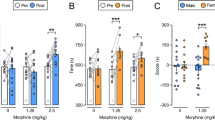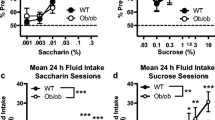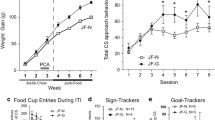Abstract
Rationale
In drug-dependent individuals, the primary excessive motivation is for drugs. Studies also indicate altered interest for “natural” rewarding activities associated with motivational disorders that may be relevant to drug dependence. However, to date, the impact of drug dependence and withdrawal upon motivation for “natural” rewards remains unclear.
Methods and objectives
In the present study, we use a food-driven operant behavior paradigm to assess the impact of opiate intake and withdrawal upon the motivational properties of highly palatable food (HPF) in mice.
Results
Our findings indicate that early (8-h) opiate withdrawal does not affect either the motivational or the discriminative properties of HPF intake. However, starting 32 h after the last morphine injection, opiate withdrawal increases operant behavior aimed at obtaining HPF. The increased HPF-driven behavior lasts at least 12 days following opiate withdrawal, indicating long-lasting effects upon motivation. Using a paradigm of reward contingency reversal, we also address the impact of opiate withdrawal upon cognitive functions. Our results indicate that opiate withdrawal does not affect the ability to learn a new operant rule to obtain HPF. Indeed, opiate withdrawal ameliorates the acquisition of the new HPF-driven operant task, most probably due to the persistent and long-lasting increased motivation. Finally, analysis of ambulatory activity and body weight (BW) changes reveal that motivational and cognitive effects are totally independent of caloric and/or motor effects of opiate dosing and withdrawal.
Conclusions
These results clearly demonstrate that excessive opiate intake and withdrawal produces dramatic and long-lasting motivational disorders relevant to drug dependence.



Similar content being viewed by others
Abbreviations
- ANOVA:
-
Analysis of variance
- B:
-
Baseline
- BP:
-
Breakpoint
- BW:
-
Body weight
- CRF:
-
Corticotropin-releasing factor
- CTL:
-
Control
- DI:
-
Discrimination index
- FR:
-
Fixed ratio
- HPF:
-
Highly palatable food
- i.p.:
-
Intraperitoneally
- OW:
-
Opiate withdrawal
- PR:
-
Progressive ratio
References
Ahmed SH, Kenny PJ, Koob GF, Markou A (2002) Neurobiological evidence for hedonic allostasis associated with escalating cocaine use. Nat Neurosci 5:625–6
American Psychiatric Association (2000) Diagnostic and statistical manual of mental disorders. Washington, DC: American Psychiatric Association (eds). pp 269-277
Arnold JM, Roberts DC (1997) A critique of fixed and progressive ratio schedules used to examine the neural substrates of drug reinforcement. Pharmacol Biochem Behav 57:441–7
Bassareo V, Di Chiara G (1997) Differential influence of associative and nonassociative learning mechanisms on the responsiveness of prefrontal and accumbal dopamine transmission to food stimuli in rats fed ad libitum. J Neurosci 17:851–61
Bruijnzeel AW, Lewis B, Bajpai LK, Morey TE, Dennis DM, Gold M (2006) Severe deficit in brain reward function associated with fentanyl withdrawal in rats. Biol Psychiatry 59:477–80, Epub 2005 Sep 19
Compton WM, Volkow ND (2006) Major increases in opioid analgesic abuse in the United States: concerns and strategies. Drug Alcohol Depend 81:103–7, Epub 2005 Jul 14
Contarino A, Papaleo F (2005) The corticotropin-releasing factor receptor-1 pathway mediates the negative affective states of opiate withdrawal. Proc Natl Acad Sci U S A 102:18649–54, Epub 2005 Dec 8
Cooper ZD, Truong YN, Shi YG, Woods JH (2008) Morphine deprivation increases self-administration of the fast- and short-acting mu-opioid receptor agonist remifentanil in the rat. J Pharmacol Exp Ther 326:920–9, Epub 2008 May 30
Cooper ZD, Shi YG, Woods JH (2010) Reinforcer-dependent enhancement of operant responding in opioid-withdrawn rats. Psychopharmacology 212:369–78, Epub 2010 Aug 5
Dalley JW, Laane K, Pena Y, Theobald DE, Everitt BJ, Robbins TW (2005) Attentional and motivational deficits in rats withdrawn from intravenous self-administration of cocaine or heroin. Psychopharmacology (Berl) 182:579–87, Epub 2005 Oct 19
Dum J, Gramsch C, Herz A (1983) Activation of hypothalamic beta-endorphin pools by reward induced by highly palatable food. Pharmacol Biochem Behav 18:443–7
Harris GC, Aston-Jones G (2003) Altered motivation and learning following opiate withdrawal: evidence for prolonged dysregulation of reward processing. Neuropsychopharmacology 28:865–71, Epub 2003 Mar 12
Harris GC, Aston-Jones G (2007) Activation in extended amygdala corresponds to altered hedonic processing during protracted morphine withdrawal. Behav Brain Res 176:251–8, Epub 2006 Nov 22
Hodos W (1961) Progressive ratio as a measure of reward strength. Science 134:943–4
Houshyar H, Gomez F, Manalo S, Bhargava A, Dallman MF (2003) Intermittent morphine administration induces dependence and is a chronic stressor in rats. Neuropsychopharmacology 28:1960–72
Houshyar H, Manalo S, Dallman MF (2004) Time-dependent alterations in mRNA expression of brain neuropeptides regulating energy balance and hypothalamo-pituitary-adrenal activity after withdrawal from intermittent morphine treatment. J Neurosci 24:9414–24
Ingallinesi M, Rouibi K, Le Moine C, Papaleo F, Contarino A (2011) CRF(2) receptor-deficiency eliminates opiate withdrawal distress without impairing stress coping. Mol Psychiatry advance online publication, 27 September 2011; doi:10.1038/mp.2011.119
Jain R, Mukherjee K, Singh R (2004) Influence of sweet tasting solutions on opioid withdrawal. Brain Res Bull 64:319–22
Kenny PJ, Chen SA, Kitamura O, Markou A, Koob GF (2006) Conditioned withdrawal drives heroin consumption and decreases reward sensitivity. J Neurosci 26:5894–900
Knapman A, Heinzmann JM, Holsboer F, Landgraf R, Touma C (2010) Modeling psychotic and cognitive symptoms of affective disorders: disrupted latent inhibition and reversal learning deficits in highly stress reactive mice. Neurobiol 94:145–52, Epub 2010 May 6
Koob GF (2008) A role for brain stress systems in addiction. Neuron 59:11–34
Koob GF, Le Moal M (2001) Drug addiction, dysregulation of reward, and allostasis. Neuropsychopharmacology 24:97–129
Krueger DD, Howell JL, Oo H, Olausson P, Taylor JR, Nairn AC (2009) Prior chronic cocaine exposure in mice induces persistent alterations in cognitive function. Behav Pharmacol 20:695–704
Laughlin RE, Grant TL, Williams RW, Jentsch JD (2011) Genetic dissection of behavioral flexibility: reversal learning in mice. Biol Psychiatry 69:1109–16
Lubman DI, Yucel M, Kettle JW, Scaffidi A, Mackenzie T, Simmons JG, Allen NB (2009) Responsiveness to drug cues and natural rewards in opiate addiction: associations with later heroin use. Arch Gen Psychiatry 66:205–12
Mark GP, Blander DS, Hoebel BG (1991) A conditioned stimulus decreases extracellular dopamine in the nucleus accumbens after the development of a learned taste aversion. Brain Res 551:308–10
Markou A, Koob GF (1992) Construct validity of a self-stimulation threshold paradigm: effects of reward and performance manipulations. Physiol Behav 51:111–9
McNally GP, Akil H (2002) Role of corticotropin-releasing hormone in the amygdala and bed nucleus of the stria terminalis in the behavioral, pain modulatory, and endocrine consequences of opiate withdrawal. Neuroscience 112:605–17
Morabia A, Fabre J, Chee E, Zeger S, Orsat E, Robert A (1989) Diet and opiate addiction: a quantitative assessment of the diet of non-institutionalized opiate addicts. Br J Addict 84:173–80
Negus SS (2006) Choice between heroin and food in nondependent and heroin-dependent rhesus monkeys: effects of naloxone, buprenorphine, and methadone. J Pharmacol Exp Ther 317:711–23, Epub 2006 Feb 2
O’Brien CP (1996) Drug addiction and drug abuse. In: Hardman JG, Limbird LE (eds) Goodman and Gilman’s the pharmacological basis of therapeutics. McGraw-Hill, New York, pp 557–577
Olausson P, Jentsch JD, Tronson N, Neve RL, Nestler EJ, Taylor JR (2006) DeltaFosB in the nucleus accumbens regulates food-reinforced instrumental behavior and motivation. J Neurosci 26:9196–204
Papaleo F, Contarino A (2006) Gender- and morphine dose-linked expression of spontaneous somatic opiate withdrawal in mice. Behav Brain Res 170:110–8, Epub 2006 Mar 31
Papaleo F, Kitchener P, Contarino A (2007) Disruption of the CRF/CRF(1) receptor stress system exacerbates the somatic signs of opiate withdrawal. Neuron 53:577–589
Papaleo F, Ghozland S, Ingallinesi M, Roberts AJ, Koob GF, Contarino A (2008) Disruption of the CRF(2) receptor pathway decreases the somatic expression of opiate withdrawal. Neuropsychopharmacology 33:2878–87, Epub 2008 Feb 20
Pecoraro N, Reyes F, Gomez F, Bhargava A, Dallman MF (2004) Chronic stress promotes palatable feeding, which reduces signs of stress: feedforward and feedback effects of chronic stress. Endocrinology 145:3754–62, Epub 2004 May 13
Prasad K, Richfield EK (2008) Sporadic midbrain dopamine neuron abnormalities in laboratory mice. Neurobiol Dis 32:262–72, Epub 2008 Jul 18
Rada P, Avena NM, Hoebel BG (2005) Daily bingeing on sugar repeatedly releases dopamine in the accumbens shell. Neuroscience 134:737–44
Robinson TE, Berridge KC (2003) Addiction. Annu Rev Psychol 54:25–53
Santolaria-Fernandez FJ, Gomez-Sirvent JL, Gonzalez-Reimers CE, Batista-Lopez JN, Jorge-Hernandez JA, Rodriguez-Moreno F, Martinez-Riera A, Hernandez-Garcia MT (1995) Nutritional assessment of drug addicts. Drug Alcohol Depend 38:11–8
Schulteis G, Koob GF (1996) Reinforcement processes in opiate addiction: a homeostatic model. Neurochem Res 21:1437–54
Schulteis G, Markou A, Gold LH, Stinus L, Koob GF (1994) Relative sensitivity to naloxone of multiple indices of opiate withdrawal: a quantitative dose–response analysis. J Pharmacol Exp Ther 271:1391–8
Short JL, Drago J, Lawrence AJ (2006) Comparison of ethanol preference and neurochemical measures of mesolimbic dopamine and adenosine systems across different strains of mice. Alcohol Clin Exp Res 30:606–20
Stinus L, Robert C, Karasinski P, Limoge A (1998) Continuous quantitative monitoring of spontaneous opiate withdrawal: locomotor activity and sleep disorders. Pharmacol Biochem Behav 59:83–9
Weiss G (1982) Food fantasies of incarcerated drug users. Int J Addict 17:905–12
Yamamoto T, Sako N, Maeda S (2000) Effects of taste stimulation on beta-endorphin levels in rat cerebrospinal fluid and plasma. Physiol Behav 69:345–50
Zhang D, Zhou X, Wang X, Xiang X, Chen H, Hao W (2007) Morphine withdrawal decreases responding reinforced by sucrose self-administration in progressive ratio. Addict Biol 12:152–7
Zijlstra F, Veltman DJ, Booij J, van den Brink W, Franken IH (2009) Neurobiological substrates of cue-elicited craving and anhedonia in recently abstinent opioid-dependent males. Drug Alcohol Depend 99:183–92, Epub 2008 Sep 26
Acknowledgements
The authors were supported by the Université de Bordeaux and the Centre National de la Recherche Scientifique (CNRS). AC was also supported by the Prix Pfizer 2005 de la Société Française d’Endocrinologie. All studies are conducted in accordance with the National Institute of Health Guide for the Care and Use of Laboratory Animals, the European Communities Council Directive of 24 November 1986 (86/609/EEC) and approved by the local Animal Care and Use Committee. The authors declare no conflict of interest.
Author information
Authors and Affiliations
Corresponding author
Electronic supplementary material
Below is the link to the electronic supplementary material.
ESM 1
PPT 368 kb
Rights and permissions
About this article
Cite this article
Rouibi, K., Contarino, A. Increased motivation to eat in opiate-withdrawn mice. Psychopharmacology 221, 675–684 (2012). https://doi.org/10.1007/s00213-011-2612-x
Received:
Accepted:
Published:
Issue Date:
DOI: https://doi.org/10.1007/s00213-011-2612-x




